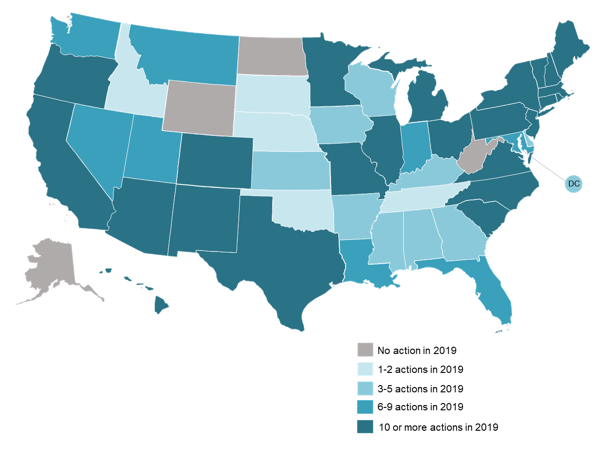The 50 States of Grid Modernization: Grid Modernization Activity Continues to Climb in 2019
Raleigh, N.C. – (February 5, 2020) The N.C. Clean Energy Technology Center (NCCETC) released its 2019 annual review and Q4 2019 update edition of The 50 States of Grid Modernization. The quarterly series provides insights on state regulatory and legislative discussions and actions on grid modernization, utility business model and rate reforms, energy storage, microgrids, and demand response.
The report finds that 46 states and the District of Columbia took actions related to grid modernization during 2019 (see figure below), with the greatest number of actions relating to energy storage deployment, customer data access policies, smart grid deployment, utility business model reforms, and distribution system planning.
2019 State and Utility Action on Grid Modernization

The report highlights ten of the top grid modernization trends of 2019:
- State regulators establishing guidelines for distribution system plans;
- Utilities failing to justify the costs of grid modernization investments;
- Utilities including new energy storage capacity in integrated resource plans;
- States considering performance incentive mechanisms;
- States enabling access to customer energy usage data;
- Utilities pursuing advanced rate design pilots;
- States considering major utility business model reforms;
- Utilities including energy storage offerings within energy efficiency and demand-side management plans;
- Regulators emphasizing programs and rates to make full use of smart meter functionality; and
- States examining interconnection and compensation rules for battery storage.
“Grid modernization activity continued to climb during 2019, with states piloting innovative ideas and considering bold policy reforms,” noted Autumn Proudlove, lead author of the report and Senior Manager of Policy Research at NCCETC. “We expect to see this momentum continue through 2020.”
A total of 612 grid modernization actions were taken during 2019, representing a 33 percent increase in activity over 2018 (460 actions). The report notes that ten of the most active states in 2019 for grid modernization were:
- North Carolina, where regulators considered Duke Energy’s Grid Improvement Plan, opened an energy storage investigation, and addressed data access and interconnection rules;
- New Hampshire, where the Commission issued its final grid modernization report and recommendations and lawmakers authorized a statewide energy data platform;
- Hawaii, where regulators continued to develop a performance-based regulation framework and approved the HECO utilities’ Phase I grid modernization investments;
- Minnesota, where utilities filed integrated distribution plans, an energy storage study was conducted, and work continued to develop performance-based regulation metrics;
- New York, where the Commission approved modifications to its value of distributed energy resources methodology and NYSERDA launched a new energy storage incentive program;
- Virginia, where regulators rejected the majority of Dominion Energy’s grid modernization proposal and an energy storage study was conducted;
- California, where the Commission issued a decision on Southern California Edison’s grid modernization plan and adopted modifications to the SGIP program;
- South Carolina, where regulators considered Duke Energy’s Grid Improvement Plan and lawmakers addressed energy storage in net metering and PURPA rules;
- Arizona, where the Commission examined retail electric competition, integrated resource planning, and the possibility of an energy storage target; and
- Colorado, where lawmakers enacted a bill requiring an investigation into performance-based regulation and the development of distribution system planning rules.
“Regulatory commissions across the county have been holding utilities to a high standard on grid modernization investments,” said David Sarkisian, Senior Policy Analyst at NCCETC. “We have seen regulators deny several proposed investment plans because of a failure to sufficiently justify costs or maximize customer benefits.”
In Q4 2019, 44 states and D.C. took some type of action on distributed solar policy or rate design. A total of 380 actions were tracked in Q4.
View the 50 States of Grid Modernization Annual Report and Q4 2019 Update Executive Summary
View and Purchase the 50 States of Grid Modernization Annual Report and Q4 2019 update FULL Report
View other 50 States Reports – Solar, Grid Modernization and Electric Vehicles
ABOUT THE N.C. CLEAN ENERGY TECHNOLOGY CENTER
The N.C. Clean Energy Technology Center, as part of the College of Engineering at North Carolina State University, advances a sustainable energy economy by educating, demonstrating and providing support for clean energy technologies, practices and policies. It serves as a resource for innovative, sustainable energy technologies through technology demonstration, technical assistance, outreach and training. For more information about the Center, visit: http://www.nccleantech.ncsu.edu. Twitter: @NCCleanTech
MEDIA CONTACT: Shannon Helm, NCCETC, shannon_helm@ncsu.edu